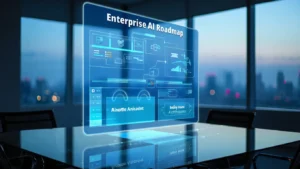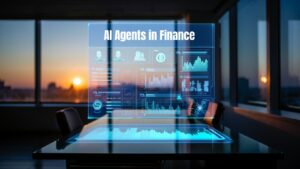At 8:30 AM, the CFO logs onto their dashboard and everything’s already in motion. Vendor payments have been scheduled, risk flags cleared, and budget variances recalculated. Nobody touched a button.
That’s the promise Agentic AI systems offer. These systems reason, plan, and act autonomously in real time. Tasks that once took days can now happen invisibly in the background.
Generative AI stops at creating content or insight, but agentic AI converts those insights into decisions and execution, updating multiple systems without human prompts. AI agents can accelerate business processes by turning static platforms into dynamic, adaptive ecosystems.
In this guide, we’ll dissect Agentic AI use cases across industries, explain how it works, explore hybrid models, identify implementation challenges, and show how RTS Labs helps turn autonomy into real business outcomes.
What Is Agentic AI?
Agentic AI is an advanced class of artificial intelligence systems capable of autonomously reasoning, planning, and executing multi-step tasks toward defined goals.
Agentic AI combines large language models (LLMs) with orchestration frameworks, tool integrations, and memory mechanisms to take context-aware actions without constant human input.
It essentially changes AI from a reactive assistant into a proactive decision-making agent, bridging the gap between insight and execution across enterprise workflows.

Modern agentic systems often rely on frameworks like LangChain, AutoGPT, BabyAGI, or CrewAI to build reasoning, memory, and tool invocation layers. These frameworks allow agents to break goals into subtasks, call APIs or databases, and adjust their plan based on feedback or changing conditions.
RTS Labs builds agentic architectures that weave these frameworks into enterprise backends, ensuring decisions are auditable, compliant, and aligned with business logic, and not black-box experiments.
How Agentic AI Works: From Goal to Action
Agentic AI operates like a digital operations manager. It doesn’t just analyze data. It decides, acts, and learns. Its workflow unfolds in five interconnected stages, transforming static insights into automated enterprise action.
1. Define the Mission
Every agent begins with a clear mission about what it must achieve, under what constraints, and how success is measured. The objectives could be “resolve support tickets under two minutes” or “reconcile monthly financials with 98% accuracy.”
The agent sets explicit business KPIs like speed, accuracy, and compliance, and aligns its objectives with enterprise goals. For example, a logistics firm defines its agent’s goal as reducing shipment rerouting delays by 15%.
2. Think and Plan
Once the mission is defined, the AI ‘thinks.’ It breaks the task into smaller steps, understands dependencies, and sequences actions logically. The reasoning process mirrors how human managers plan workflows, except it’s powered by LLMs capable of analyzing millions of variables in seconds.
For example, In finance, an agent might plan to cross-check ledger entries, verify anomalies, and trigger reconciliation automatically.
3. Connect and Act
Agentic AI doesn’t work in isolation. Rather, it integrates with ERPs, CRMs, databases, and APIs to execute its plan and facilitate real-time actions like updating records, sending notifications, or triggering follow-up workflows.
For example, a retail agent detects stockouts in SAP and automatically places restock orders via Shopify and supplier APIs.
4. Learn and Adapt
Through continuous memory and feedback loops, the agent learns from every action.
It remembers what worked, identifies edge cases, and refines its approach over time, thereby reducing reliance on manual fine tuning.
For example, an insurance agent recalls which fraud patterns previously triggered human review and updates its risk thresholds dynamically.
5. Govern and Improve
Human-in-the-loop (HITL) frameworks ensure control and accountability. Agents flag exceptions, log decisions for audits, and incorporate human feedback into retraining cycles.
For example, a compliance agent automatically drafts audit summaries but sends them for human approval before submission.
RTS Labs helps enterprises architect these systems end-to-end, ensuring AI operates safely, efficiently, and at scale. Contact us here.
Benefits of Agentic AI
Agentic AI unlocks tangible value by elevating automation into intelligent, autonomous operations. Below are three core benefit pillars, each illustrated with examples and data to ground expectations.
Autonomous Efficiency and Cost Reduction
Agentic AI empowers systems to act on insights without human intervention, to reduce manual workload and operational friction. For example, an insurance agentic module might auto-resolve claims that fall under certain thresholds to reduce back-office processing time.
In logistics, predictive maintenance agents can detect anomalies and schedule repairs proactively to cut unplanned downtime and associated costs.
These automation gains translate directly into dollars saved, fewer errors, lower headcount impact in routine tasks, and smoother operations at scale.
Scalable, Contextual Intelligence
Agentic AI systems don’t just scale tasks. They scale decision intelligence across domains. They maintain memory, learn from outcomes, and adapt their behavior over time. Some enterprises report that AI agents helped boost staff efficiency by 61% in insurance processes.(Research report by Sprout.ai)
Agents can embed business rules and domain constraints to offer more reliable, consistent decisions than standalone generative models. In finance, for example, the agent may flag suspicious entries, reconcile accounts, and execute corrective actions, all while tracking reasoning trails and context.
This capability allows organizations to extend automation beyond simple tasks to complex, context-aware processes across departments and workflows.
Strategic Agility & Competitive Edge
When intelligence lives inside your operations, the enterprise can respond in real time. McKinsey estimates that AI capabilities across functions could unlock $4.4 trillion in productivity gains globally.
Agentic AI takes it a step further. Using it, insights aren’t idle. Instead they become triggers for execution. For instance, in a fast-moving supply chain disruption, an agent can reroute shipments, rebalance inventory, and notify stakeholders, all in a single reflex.
Early adopters of agentic systems shift from reactive to proactive operations to diagnose not just failures but also prevent them. That gives a competitive lead in efficiency, customer responsiveness, and resilience.
TL;DR
Agentic AI amplifies value not by adding incremental intelligence but by unifying insight and execution, delivering measurable efficiency, adaptability, and strategic responsiveness.
Top Agentic AI Use Cases and Real-World Examples
Agentic AI streamlines enterprise operations by connecting intelligence to action.
Agentic Ai architectures don’t stop at recommendations. They execute to close the loop between insight, decision, and outcome.
Below are seven high-impact use cases showing how autonomous AI agents are already reshaping industries in measurable ways.
1. Customer Support & Service Automation
Modern AI agents can manage support tickets autonomously. They classify, resolve, or escalate customer issues without human input. Agentic systems integrate with CRM and helpdesk platforms like Salesforce, Zendesk, and ServiceNow to respond, troubleshoot, and follow up in real time.
Do you know?
70% of CX leaders believe that Agentic AI in customer service has made interaction more efficient.
~ Zendesk Customer Experience Trends Report 2024
The impact Agentic AI brings is commendable. Companies report
- A 37% decrease in first response times
- Reduction in customer service staffing needs by 68% during peak season, and 51% during the rest of the year (Gladly)
- 52% increase in ticket resolving speed
RTS Labs designs multilingual, compliance-ready agentic workflows that merge NLP with CRM actions for enterprise-grade accuracy and traceability.
2. Fraud Detection & Automated Resolution
Agentic AI doesn’t just flag suspicious transactions. It goes a step ahead to investigate and initiate actions. Thailand based credit card provider, KTC, deployed AI in fraud management, and exceeded its 85% fraud detection target to reduce losses.
Agents monitor financial data streams, cross-check identities, freeze high-risk accounts, and escalate to compliance officers. For insurers and banks, RTS Labs builds multi-agent frameworks that connect fraud analytics models with ERP/CRM systems, automatically generating investigation reports.
3. IT & DevOps Automation
Agentic AI powers self-healing infrastructure. It detects incidents, diagnoses causes, and applies fixes, without waiting for human engineers. Gartner (2025) predicts that 40% of DevOps tasks will be automated via AI agents by 2026.
For example, an agent detects server lag, deploys a patch, and re-routes traffic while alerting the DevOps team. RTS Labs engineers design agentic pipelines using observability data and API orchestration to reduce downtime and manual workload.
4. Financial Planning & Automated Reporting
AI agents can now handle end-to-end financial closes, reconciling data, generating statements, and validating compliance. 42% of CFOs report implementing Ai in their business software(Deloitte).
Finance departments using AI automation to reduce manual data entry tasks by 55% (Karbonhq report), improve speed by 40%, and decision making accuracy by 30%.
A CFO AI agent can gather ERP data, reconcile ledgers, and submit compliance-ready reports in no time. RTS Labs implemented an agentic finance dashboard that flags anomalies, triggers reconciliations, and forecasts liquidity in real time.
5. Construction & Project Management
Construction and engineering firms deploy agentic systems to coordinate field operations, materials, and risk prediction. Agents track equipment usage, reorder supplies, and flag safety compliance gaps automatically.
A study published in the Journal of Construction Engineering and Management found that the use of AI in construction planning reduced project delays by up to 30% and decreased rework by up to 50%. RTS Labs integrates AI agents into BIM and ERP tools to automate scheduling, resource allocation, and change management.
6. Healthcare Workflow Orchestration
Agentic AI connects the dots across patient care to handle tasks from scheduling to claims. A study showed how Hospital networks using AI-driven scheduling improved appointment throughput by 32% .
Agents sync EHR, billing, and scheduling systems to reduce administrative friction. RTS Labs develops HIPAA-compliant agents that handle intake, billing, and coordination, freeing clinicians to focus on care.
7. Supply Chain Optimization
Agentic AI makes logistics adaptive. During port disruptions, an AI agent can reroute shipments, update ETAs, and alert customers autonomously. PwC found that agentic forecasting can reduce maintenance costs by 30% and unplanned downtime by 45%.
RTS Labs builds connected AI agents that analyze IoT + ERP data for predictive inventory management.
Hybrid Use Cases: When Generative & Agentic AI Work Together
Rather than thinking of generative AI and agentic AI as separate modes, the most powerful enterprise deployments weave them together. Here are hybrid workflows where combined intelligence and execution deliver impact.
1. Conversational Intelligence + Workflow Automation in Logistics and Transportation
A shipping company’s support team receives free-text requests like “I want to change delivery date,” “I lost my package,” and then must route tasks manually in multiple systems.
Here, Generative AI (e.g. an LLM) can interpret user intent, draft structured action items, such as “reschedule delivery to Tuesday, notify hub, update tracking”. The agentic layer can then execute those tasks, update the ERP, schedule transport, and send notifications end-to-end without human handoff.
RTS Labs built a conversational AI platform for logistics firm Evergreen that enabled real-time order tracking and self-service workflows. The agent helped reduce manual coordination, minimize delays, and ensure consistency between what customers ask and what systems do.
2. Document Generation for Decision Execution in Legal, Compliance, and Insurance
Legal and compliance teams receive drafts or regulatory updates from which they need to produce summaries, suggestions, and then enforce rules or update policies across systems.
Here, Generative AI reads regulation changes and drafts a summary or rule-updates. The agentic system parses that summary, alerts affected departments or triggers workflows to update policy, send memos, enforce rules automatically.
We helped legal firm PLG with their legal work and streamlined the demand-letter process with AI-powered drafting automation to reduce drafting time by 91%.
3. Insights to Action in Finance, Risk and Fraud Use Cases
A finance team may get a generative AI–produced anomaly alert or narrative like “Unusual spike in vendor payments this week”. But the team still must dig into systems, decide on actions, and execute them.
Here, the generative model produces anomaly reports or risk narratives. The agentic engine then triggers actions to freeze transactions, flag to audit teams, send follow-up requests, or update dashboards.
RTS Labs deploys systems that detect anomalies in real time and enabled timely mitigation across operations
4. Generative Planning + Agentic Execution in Supply Chain and Inventory
A supply chain planner may use generative AI to forecast demand and generate plans. But executing that plan still involves manual order placements, approvals, and routing.
The generative model can produce the optimized plan. But the agentic module then executes procurement orders, adjusts inventory allocations, triggers logistics workflows, and monitors deviations. We use advanced AI algorithms to optimize inventory, demand forecasting, and self-adjusting supply systems.
Challenges in Scaling Agentic AI
While Agentic AI offers autonomy and speed, scaling it across enterprise systems introduces a new class of challenges that go beyond traditional AI governance.
1. Data Privacy & Regulatory Compliance
Agentic AI often accesses live enterprise systems, like ERP, CRM, HRIS, and external APIs. This creates a large compliance footprint and sensitive data exposure or policy violations.
According to IBM’s study, 40% of enterprises cite “data governance complexity” as their top challenge when deploying advanced AI systems. To tackle the same, we implement strict access controls, encryption, and HITL (Human-in-the-Loop) review checkpoints to ensure traceability and compliance (GDPR, HIPAA, SOC 2).
2. Over-Autonomy & Reliability
Unchecked autonomy can lead to cascading errors, for e.g., an AI system executing incorrect financial transactions. 45% of the leaders state concerns about the accuracy or bias involved in AI agent implementation.
We introduce Ai governance and guardrails, such as rule-based execution thresholds, explainability logs, and approval workflows, before high-impact actions are executed.
3. Integration Complexity
Agentic systems must talk to legacy software and modern cloud tools. IBM reports that 45% of firms report inadequacy of sufficient proprietary data to customize Ai solutions. And many firms struggle to connect AI agents to existing enterprise systems due to API and workflow fragmentation.
We use modular, API-first integration frameworks with middleware orchestration layers to minimize downtime and ensure plug-and-play extensibility.
4. Change Management & Adoption
Automation can shift employee roles and trigger resistance. 42% of professionals state inadequacy in AI expertise for a seamless adoption experience. We introduce co-pilot modes first, allowing humans to observe AI decision paths before full automation, improving trust and adoption.
Implementation Roadmap for Agentic AI Deployment
Enterprises achieving measurable ROI from agentic AI typically follow a structured path. RTS Labs recommends this six-step blueprint:
| Phase | Key Actions | Deliverables |
|---|---|---|
| 1. Discovery & Goal Definition | Identify automation opportunities, KPIs, and risk appetite | Use-case matrix, success metrics |
| 2. Data Audit & Preparation | Clean, unify, and label operational data across systems | Data pipeline blueprints |
| 3. Prototype Development | Build a small-scope agent in a sandbox (e.g., invoice processing) | Working prototype + feedback loop |
| 4. Pilot & HITL Validation | Test the agent with humans in the loop to validate accuracy and compliance | Performance report + governance checklist |
| 5. Integration & Scale-Up | Connect to ERP/CRM, deploy orchestration layers, and monitor with observability dashboards | API integrations + monitoring stack |
| 6. Continuous Optimization | Capture user feedback, retrain models, and expand to new workflows | Iterative updates + ROI tracking dashboard |
Agentic AI Will Help Enterprises Move From Experiments to Enterprise Intelligence
Agentic AI is the bridge between AI-assisted thinking and autonomous execution. When combined with Generative AI, it becomes the core of an intelligent enterprise, where decisions are not just predicted, they are acted upon safely, instantly, and at scale.
RTS Labs helps organizations move beyond experimentation to full-fledged automation ecosystems through:
- Tailored multi-agent architectures aligned with business KPIs
- Hybrid AI frameworks merging creativity with operational precision
- Built-in governance, compliance, and continuous learning systems
Partner with RTS Labs to identify, design, and scale agentic AI use cases that enhance operations, from finance to logistics, with measurable ROI and enterprise-grade security.
FAQs
1. What’s the difference between Generative AI and Agentic AI?
Generative AI produces content like text, code, visuals. Agentic AI goes further to tackle reasoning, planning, and taking autonomous actions.
2. What industries benefit most from Agentic AI?
Finance, logistics, healthcare, insurance, and all sectors requiring automation of high-volume, rule-based decisions.
3. How can businesses ensure safety in Agentic AI deployment?
Through human-in-the-loop workflows, explainability dashboards, and governed decision-logs, all core RTS Labs safeguards.
4. Can Agentic AI integrate with legacy ERP or CRM systems?
Yes. RTS Labs builds API-driven connectors to link new AI layers with existing enterprise systems seamlessly.
5. Why partner with RTS Labs for Agentic AI?
Because RTS Labs combines AI strategy, custom engineering, and governance expertise , delivering tailored solutions faster and more safely than large consultancies.






